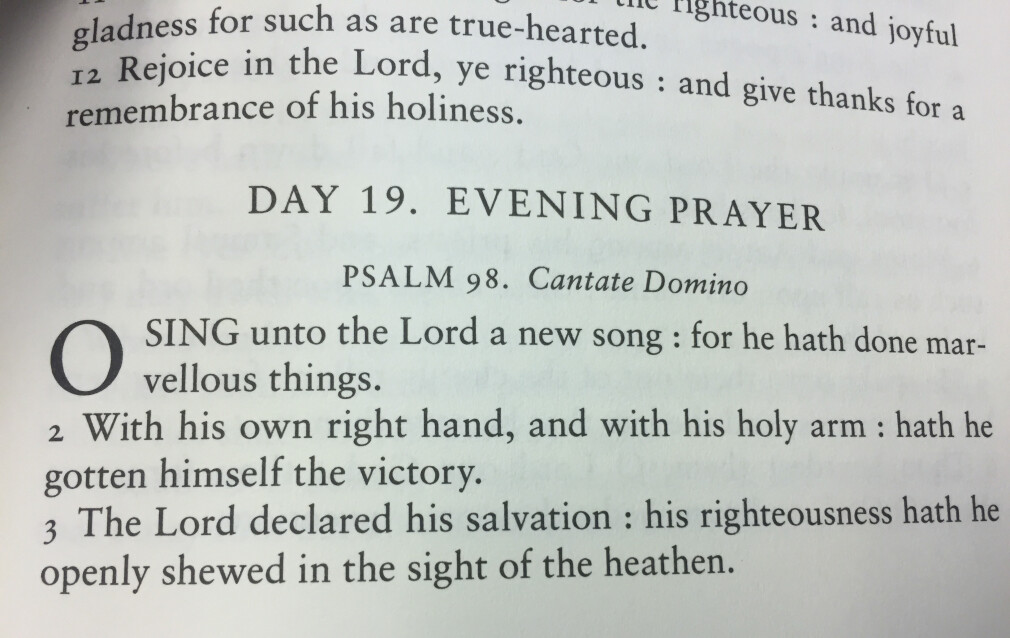Instructed Eucharist in review: Church music as an obsession with Psalms

I don’t plan to write regularly in this space this summer, even though I have just recently started this blog. But I have been thinking so much about the role of our music in our services at St. Peter’s in light of this past Sunday’s Instructed Eucharist and Rector’s Forum, and I want to write a little bit more in depth here. We will hold Part 2 of the Instructed Eucharist (focusing on Holy Communion) on Sunday, September 2.
Our church music could best be described as an obsession with Psalms.
The Psalms are so important to Anglicanism that they have been reprinted in every Book of Common Prayer (BCP) since 1662.
This same 1662 version of the Psalter was included in American BCPs until 1928. In the lead up what became the 1979 BCP, the Psalms were carefully retranslated, and one of the poets involved was W. H. Auden. (There is a fascinating book about 1979 Psalter by J. Chester Johnson, the poet who succeeded Auden on the committee, called Auden, the Psalms, and Me.)
One of the reasons that the Book of Psalms is the only book of the bible to be
If you look closely at the Psalms in the prayer book, you will notice that the psalter is divided into a monthly cycle. This is the cycle to which we adhere at services of Evensong at St. Peter’s. For instance, if you come to Evensong on the 15th of the month, the Psalms you will hear sung are those designated for the 15th Evening.
And while Anglicans best know the Psalms as part of daily prayer, they have a much longer more complicated history as part of the order of Holy Communion.
This work continues, even here at St. Peter’s. And I’ll explain our unique role in this below.
Let’s now turn our attention to the order of the service itself, and I think you’ll see just how influential the Psalms have been in the history and practice of our church music.
Organ Prelude
Music before the service is a kind of “sonic incense.” It’s in the air as people arrive. For many worshippers, it accompanies private prayer and devotions before the service. For some worshippers, the specifics of this music itself may be the stuff or prayer and devotion. In another sense, this is the music that accompanies the first "procession" of the service: the arrival of the People. A good organ prelude reflects the sounds of the music for the day and the character of the liturgical season.
Introit
The Introit was originally a Psalm sung at the entrance of the ministers. The Introit Psalm was proper to
In many places today, you find that any piece of choral music will suffice for an introit, but the yearly rotation of Introit Psalms was fixed and was an expected part of worship in many places. The words of all the proper Introits for the year are printed in the back of the English Hymnal of 1906. And it is from this hymnal that we sing our Introits here at St. Peter’s. These Introits were historically sung to plainsong tones. But, being good Anglicans, I have provided Anglican Chant for the Introits for the whole year. To the best of my knowledge, we are the only church to sing the Introits this way.
Entrance Hymn
If the Introit was originally sung at the entrance of the ministers, you might notice that we don’t do it this way anymore. We delay the entrance of the ministers until the singing of a hymn when all can be involved in the music. This first hymn of the service allows all who have gathered to sing together and to open themselves to the presence of Christ. Led by the Cross, the Choir and Clergy enter the church. This act symbolizes the gathering of the community in the name of Christ.
This points to one of the most consistent trends in church music in recent centuries: that of the increasing musical participation of the congregation.
Gloria in
Historically the Gloria was the great Song of Praise of the church sung as part of this entrance Rite. But for much of the history of the Book of Common Prayer, it has been relegated to the end of Communion. As recently as the 1928 BCP, the Gloria was sung after the Postcommunion Prayer.
This is where the liturgical reform movement of the 1950s, 60s, and 70s has done some great work in recovering a more ancient pattern. Our 1979 BCP restores the Gloria to its historic place as part of the entrance rite.
The Gloria, a regular part of Christian worship for a millennium, begins with the song of the angels in Luke 2:14.
Psalm
All early Christian writers who mention the Psalms say they were sung. At St. Peter's it is our tradition to say the Psalm responsively in services of Holy Eucharist. But the Psalm is a relatively new addition to this liturgy of the Holy Eucharist. Verses of the Psalms were found in the minor propers of the service (the Introit, Gradual, Offertory, Communion). With the disappearance of many of these Psalm
Hymns
The first Anglican hymns were, you guessed it, Psalms.
The development of hymn singing in the Anglican Church began with metrical paraphrases of the Psalms. These were rhymed hymns that were very closely based on Psalm texts.
One of the first collections of these Psalm paraphrases was known by the last name of its authors/compilers: the Sternhold and Hopkins psalter. Hymn 378 in our Hymnal comes from this collection. It is a paraphrase of Psalm 100 by William Kethe.
All people that on earth do dwell,
sing to the Lord with cheerful voice:
Him serve with fear, his praise forth tell,
come ye before him and rejoice.
Another familiar hymn that you may not think of as a Psalm paraphrase is by the prolific hymn writer Isaac Watts: "Joy to the world, the Lord is come". Here, we begin to see a development of the paraphrase tradition. Watts is drawing from more than one Psalm, and incorporating other verses of scripture. "Joy to the world" is a paraphrase of verses from Psalms 98 and 96 with a sprinkle of Genesis 3.
Interestingly, the previous hymnal of the Episcopal Church, the Hymnal 1940, lists this as an General hymn (in the Rector's Forum I mistakenly said "Advent"). Look for it soon at a non-Christmas service near you, possibly sung to the hymn tune ‘Richmond’ as it was in the Hymnal 1940.
Joy to the World; The Lord
is come ;
Let Earth receive her King:
Let every Heart prepare him Room,
And Heaven and Naturesing .
After this, the hymn writing skill Charles Wesley and others helped establish the hymn as a worthy genre of sacred music for Anglican worship, one that need not have a literal basis in a Psalm.
In the last half century or so, we have enjoyed what many have described a "hymn explosion" with new voices and styles being introduced at a rapid pace.
At present the Episcopal Church enjoys a wide and ecumenical breadth in her hymnody, though it should be noted that we will now be the last mainline denomination to revise our hymnal (should General Convention choose to do so). Our 1982 Hymnal was seen as pioneering at the time, but in the years since the Congregationalists, Lutherans, Methodists, Presbyterians, and others have all updated their hymnals, and some of them more than once.

